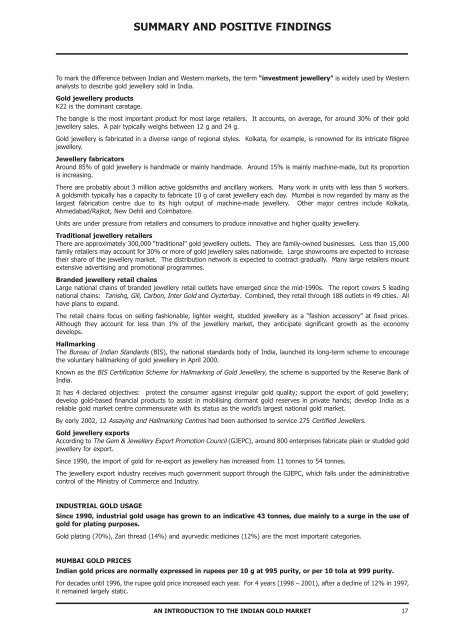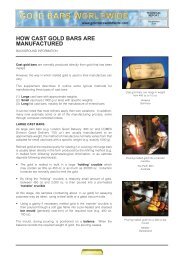Indian Gold Book:Indian Gold Book - Gold Bars Worldwide
Indian Gold Book:Indian Gold Book - Gold Bars Worldwide
Indian Gold Book:Indian Gold Book - Gold Bars Worldwide
Create successful ePaper yourself
Turn your PDF publications into a flip-book with our unique Google optimized e-Paper software.
SUMMARY AND POSITIVE FINDINGS<br />
To mark the difference between <strong>Indian</strong> and Western markets, the term “investment jewellery” is widely used by Western<br />
analysts to describe gold jewellery sold in India.<br />
<strong>Gold</strong> jewellery products<br />
K22 is the dominant caratage.<br />
The bangle is the most important product for most large retailers. It accounts, on average, for around 30% of their gold<br />
jewellery sales. A pair typically weighs between 12 g and 24 g.<br />
<strong>Gold</strong> jewellery is fabricated in a diverse range of regional styles. Kolkata, for example, is renowned for its intricate filigree<br />
jewellery.<br />
Jewellery fabricators<br />
Around 85% of gold jewellery is handmade or mainly handmade. Around 15% is mainly machine-made, but its proportion<br />
is increasing.<br />
There are probably about 3 million active goldsmiths and ancillary workers. Many work in units with less than 5 workers.<br />
A goldsmith typically has a capacity to fabricate 10 g of carat jewellery each day. Mumbai is now regarded by many as the<br />
largest fabrication centre due to its high output of machine-made jewellery. Other major centres include Kolkata,<br />
Ahmedabad/Rajkot, New Dehli and Coimbatore.<br />
Units are under pressure from retailers and consumers to produce innovative and higher quality jewellery.<br />
Traditional jewellery retailers<br />
There are approximately 300,000 “traditional” gold jewellery outlets. They are family-owned businesses. Less than 15,000<br />
family retailers may account for 30% or more of gold jewellery sales nationwide. Large showrooms are expected to increase<br />
their share of the jewellery market. The distribution network is expected to contract gradually. Many large retailers mount<br />
extensive advertising and promotional programmes.<br />
Branded jewellery retail chains<br />
Large national chains of branded jewellery retail outlets have emerged since the mid-1990s. The report covers 5 leading<br />
national chains: Tanishq, Gili, Carbon, Inter <strong>Gold</strong> and Oyzterbay. Combined, they retail through 188 outlets in 49 cities. All<br />
have plans to expand.<br />
The retail chains focus on selling fashionable, lighter weight, studded jewellery as a “fashion accessory” at fixed prices.<br />
Although they account for less than 1% of the jewellery market, they anticipate significant growth as the economy<br />
develops.<br />
Hallmarking<br />
The Bureau of <strong>Indian</strong> Standards (BIS), the national standards body of India, launched its long-term scheme to encourage<br />
the voluntary hallmarking of gold jewellery in April 2000.<br />
Known as the BIS Certification Scheme for Hallmarking of <strong>Gold</strong> Jewellery, the scheme is supported by the Reserve Bank of<br />
India.<br />
It has 4 declared objectives: protect the consumer against irregular gold quality; support the export of gold jewellery;<br />
develop gold-based financial products to assist in mobilising dormant gold reserves in private hands; develop India as a<br />
reliable gold market centre commensurate with its status as the world’s largest national gold market.<br />
By early 2002, 12 Assaying and Hallmarking Centres had been authorised to service 275 Certified Jewellers.<br />
<strong>Gold</strong> jewellery exports<br />
According to The Gem & Jewellery Export Promotion Council (GJEPC), around 800 enterprises fabricate plain or studded gold<br />
jewellery for export.<br />
Since 1990, the import of gold for re-export as jewellery has increased from 11 tonnes to 54 tonnes.<br />
The jewellery export industry receives much government support through the GJEPC, which falls under the administrative<br />
control of the Ministry of Commerce and Industry.<br />
INDUSTRIAL GOLD USAGE<br />
Since 1990, industrial gold usage has grown to an indicative 43 tonnes, due mainly to a surge in the use of<br />
gold for plating purposes.<br />
<strong>Gold</strong> plating (70%), Zari thread (14%) and ayurvedic medicines (12%) are the most important categories.<br />
MUMBAI GOLD PRICES<br />
<strong>Indian</strong> gold prices are normally expressed in rupees per 10 g at 995 purity, or per 10 tola at 999 purity.<br />
For decades until 1996, the rupee gold price increased each year. For 4 years (1998 – 2001), after a decline of 12% in 1997,<br />
it remained largely static.<br />
AN INTRODUCTION TO THE INDIAN GOLD MARKET 17

















